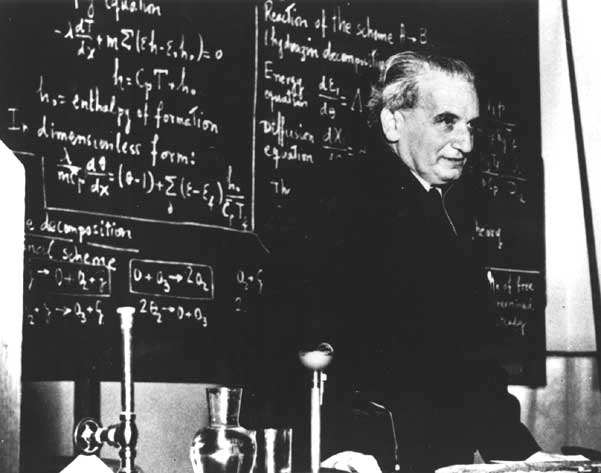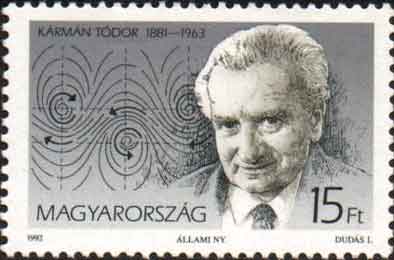.
Theodore von Karman

Dr. Theodore von Karman, co-founder of the Jet Propulsion Laboratory (JPL) Pasadena, California
Theodore von Kármán (Szőllőskislaki Kármán Tódor) (May 11, 1881 - May 6, 1963 ) was an engineer and physicist who was active primarily in the fields of aeronautics during the seminal era in the 1940s and 1950s. He is personally responsible for many key advances in aerodynamics, notably his work on supersonic and hypersonic airflow characterization.
He was born in Budapest, Hungary as Kármán Tódor, studied engineering at the city's Royal Technical University, graduating in 1902. He then joined Ludwig Prandtl at the University of Göttingen, and received his doctorate in 1908. He taught at Göttingen for four years. He became fascinated by flight, and in 1912 took a job as director of the Aeronautical Institute at the University of Aachen. He stayed there until 1930 (interrupted by service in the Austro-Hungarian army 1915-1918, where he designed an early helicopter).
Apprehensive about developments in Europe, in 1930 he accepted the directorship of the Guggenheim Aeronautical Laboratory at the California Institute of Technology and emigrated to the United States. In 1936, with Frank Malina he founded a company Aerojet to manufacture JATO rocket motors. Also in 1936, he became a naturalized citizen of the United States.

In 1944 he helped found the Jet Propulsion Laboratory (now a part of NASA), and became the first chairmain of the Scientific Advisory Group in 1946, which studied aeronautical technologies for the United States Army Air Forces. He also helped found AGARD, the NATO aerodynamics research oversight group (1951), the International Council of the Aeronautical Sciences (1956), the International Academy of Astronautics (1960), and the von Karman Institute in Brussels.
Kármán's fame was in the use of mathematical tools to study fluid flow, and the interpretation of those results to guide practical designs. He was instrumental in recognizing the importance of the swept-back wings that are ubiquitous in modern jet aircraft.
Specific contributions include theories of non-elastic buckling, unsteady wakes in circum-cylinder flow, stability of laminar flow, turbulence, airfoils in steady and unsteady flow, boundary layers, and supersonic aerodynamics.
He made additional contributions in other fields, including elasticity, vibration, heat transfer, and crystallography. His name appears in at least the following concepts:
- Theodore von KármánKarman line (aerodynamics/astronautics)
- von Kármán vortex street (flow past cylinder)
- Prandtl-von Kármán law (velocity in open channel flow)
- von Kármán integral equation (boundary layers)
- Kármán-Pohlhausen parameter (boundary layers)
- Kármán-Treffz transformation (airfoil theory)
- Kármán-Nikuradse correlation (viscous flow)
- Chaplygin-Kármán-Tsien approximation (potential flow)
- Falkowich-Kármán equation (transonic flow)
- von Kármán-Tsien compressibility correction
- von Kármán ogive (supersonic aerodynamics)
- Born-von Kármán lattice model (crystallography)
- Craters on Mars and the Moon are named in his honor.
University of Southern California Professor Shirley Thomas (after nearly two decades of petitioning) was able to create a a stampin his honor. It was first issued in 1992.
Links
School of Mathematics and Statistics, University of St. Andrews, Scotland page on Theodore von Kármán
Books
Aerodynamics - Selected Topics in the Light of their Historical Development, (Cornell University Press, Ithaca, 1954).
Collected Works, (4 Volumes), Von Karman Institute, Rhode St. Genese, 1975 (limited edition book); also Butterworth Scientific Publ, London 1956. (Many papers from vols. 1 and 2 are in German.)
From Low Speed Aerodynamics to Astronautics, (Pergamon Press, London, 1961).
(with L. Edson) The Wind and Beyond - Theodore von Kármán Pioneer in Aviation and Pathfinder in Space (Little Brown, 1967).
References
- S. Goldstein, "Theodore von Kármán, 1881-1963", Biographical Memoirs of Fellows of the Royal Society of London 12 (1966), 335-365.
- D. S. Halacy Jr, Father of Supersonic Flight: Theodor von Kármán (1965).
- M. H. Gorn, The Universal Man: Theodore von Kármán's Life in Aeronautics (Smithsonian Institution Press, Washington, 1992).
- G. Gabrielli, "Theodore von Kármán", Atti Accad. Sci. Torino Cl. Sci. Fis. Mat. Natur. 98 (1963/1964), 471-485.
- J. L. Greenberg and J. R. Goodstein, "Theodore von Kármán and applied mathematics in America", Science 222 (4630) (1983), 1300-1304.
- J. L. Greenberg and J. R. Goodstein, "Theodore von Kármán and applied mathematics in America", A century of mathematics in America II (Providence, R.I., 1989), 467-477.
- R. C. Hall, "Shaping the course of aeronautics, rocketry, and astronautics: Theodore von Kármán, 1881-1963", J. Astronaut. Sci. 26 (4) (1978), 369-386.
- J. Polásek, "Theodore von Kármán and applied mathematics" (Czech), Pokroky Mat. Fyz. Astronom. 28 (6) (1983), 301-310.
- W. R. Sears, "Some recollections of Theodore von Kármán", J. Soc. Indust. Appl. Math. 13 (1965), 175-183.
- W. R. Sears, "Von Kármán: fluid dynamics and other things", Physics today 39 (1986), 34-39.
- F. L. Wattendorf, "Theodore von Kármán, international scientist", Z. Flugwiss. 4 (1956), 163-165.
- F. L. Wattendorf and F. J. Malina, "Theodore von Kármán, 1881-1963", Astronautica Acta 10 (1964), 81.
Retrieved from "http://en.wikipedia.org/"
All text is available under the terms of the GNU Free Documentation License

